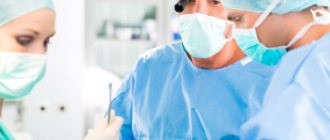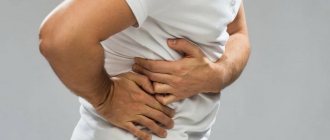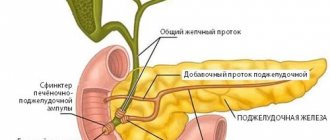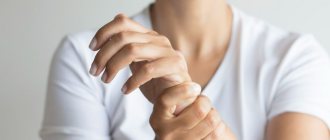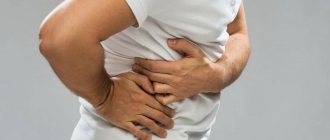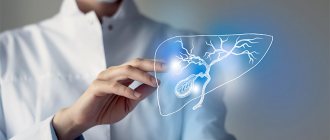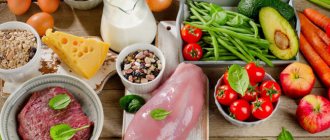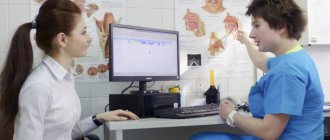The gallbladder performs an important function in the body; disruption of its functioning can lead to very unpleasant consequences. Bile produced by the liver is stored in the gallbladder until the body needs it. This usually happens when food enters the stomach. Bile begins to flow into the duodenum, where, together with pancreatic juice, it helps digest food and facilitates bowel function. What are the symptoms of a kinked gallbladder?
Symptoms of a bent gallbladder
Ultrasound of the gallbladder
If a malfunction occurs in the body, such as a bend in the gallbladder, the symptoms of which will be described below, the outflow of bile is disrupted, and bile, as is known, is quite caustic and can damage any organ, including the gallbladder itself.
- Nausea and vomiting. Nausea and vomiting may occur periodically, especially after a large meal. A dangerous sign is constant nausea and frequent vomiting. In this case, we can talk about a threat to life.
- Constipation. Impaired digestion and insufficient flow of bile into the duodenum lead to the fact that the intestines cannot cope with their work. Constipation when the gallbladder is bent is inevitable.
- Gastric reflux. This is a painful and dangerous syndrome, the essence of which is that the standard chain of food promotion is disrupted. From the intestines, bile with semi-digested food remains enters the stomach, which causes pain, heartburn, nausea, and in some cases even a burn of the gastric mucosa.
- Sweating. Excessive sweating is a manifestation of general weakness of the body. If the pain is severe, cold, sticky sweat may also appear.
- Bloating. The release of bile into the stomach and its contact with the acidic environment prevailing in the stomach contributes to increased gas formation. The patient experiences a feeling of bloating that does not go away even after visiting the toilet.
- Pain in the right side. Abdominal pain is usually aching in nature. When bile enters the stomach, a feeling of pain in the abdomen may occur.
- Bitterness in the mouth. The presence of bile in the stomach and even the esophagus causes a feeling of unpleasant bitterness in the mouth.
Tests and diagnostics
- Ultrasound diagnostics is the main and informative method of research for this disease. The deformity of the bladder may disappear when changing body position or protruding the abdomen. To study the function of the gallbladder, ultrasound is often performed in two stages - on an empty stomach and after a choleretic breakfast.
- If necessary, hepatobiliscintigraphy is performed. Hepatobiliscintigraphy is an X-ray radiological method for studying liver function (bile production and bile secretion) with the introduction of a radiopharmaceutical (isotope). The study is carried out in a gamma camera, where images are taken every 2-5 minutes. The study determines the level of deformation and evaluates the condition of the biliary tract.
- CT scan.
- General clinical tests and biochemical (liver tests).
Causes
A bend in the gall bladder can occur in any part of the organ.
A bend can occur in various parts of the gallbladder for a variety of reasons. The most dangerous thing is the bending of the body of the gallbladder, in which bile is released in fairly large quantities. Let's look at the main causes of gallbladder bending:
- Great physical activity. With physical exertion and regular lifting of weights, prolapse of internal organs can occur, which leads to kinking of the gallbladder with all the consequences.
- Obesity. Obesity has a detrimental effect on many internal organs. They become covered with fat, become deformed, and shift. The gallbladder is no exception. A kink in the gallbladder is not the worst thing that can happen with severe obesity, but its consequences are noticeable.
- Congenital pathology. This is perhaps the most common cause of a bent gallbladder. During the formation of the internal organs of the embryo, a disturbance in the proportion of growth and size of the organs may occur. In this case, the liver and gall bladder are subject to deformation. Such changes can last a lifetime.
- Pregnancy. During pregnancy, the uterus grows and puts pressure on the internal organs. The liver and gallbladder may also suffer from this. Then a temporary bend of the gallbladder is formed, which is subject to restoration after childbirth. However, this is rare. Most often, the bend is congenital, but makes itself felt only during pregnancy.
- Poor nutrition. Alternating fasting with overeating leads to increased production of pancreatic juice and stagnation of bile.
- Age-related changes. With age, internal organs prolapse, which leads to kinking of the gallbladder, age-related constipation and other diseases.
- Atypical location of the gallbladder. In addition to congenital deformation of the gallbladder, it may also have an atypical location relative to the liver. In this case, the gallbladder becomes more mobile and prone to kinks and stagnation of bile.
Photo
The photo below shows different types of pathology, in which the bladder is twisted in different places. And it is also shown, using the example of torsion in the cervical area, what a healthy and changed organ looks like.
Treatment of gallbladder inflection
Gallbladder: schematic representation of organ placement
Treatment is prescribed individually and only by the attending physician. Self-medication is not recommended. Before this, it is necessary to undergo diagnostics, identify the causes of the bend in the gallbladder, specify the location of the bend, only after an ultrasound and tests the doctor will prescribe treatment:
- Choleretic drugs. If the gallbladder is bent, choleretic drugs are prescribed to improve the flow of bile into the intestinal lumen. Similar drugs include Hofitol, Allohol. A drug called Aristochol contains medicinal herbs and acts in several directions at once: improves intestinal function, increases the flow of bile and relieves spasms.
- Painkillers and antispasmodics. For pain, the doctor prescribes painkillers and antispasmodics, such as Drotaverine, No-Shpa, Baralgin. For nausea and vomiting, intramuscular injections are possible.
- Antibiotics. The doctor may prescribe antibiotics for cholecystitis, if the gallbladder is bent due to an infection that provokes inflammation of the gallbladder mucosa. Ampiox is often prescribed.
- Physical procedures. Physiotherapy is most often aimed at warming up: ozokerite therapy, paraffin therapy.
- Breathing exercises. The abdominal type of breathing is useful, when with each inhalation the diaphragm and abdominal organs develop. This will help avoid bile stagnation.
- Vitamin therapy. Vitamins will help strengthen the general condition of the body, increase immunity, which is especially important when there is an excess caused by infection.
- Traditional medicine. Choleretic herbs include milk thistle, tansy, and immortelle. Tansy decoction also has an analgesic effect. It is also recommended to take a decoction of rose hips, valerian, chamomile with mint, and hop cones. For gallbladder diseases, it is sometimes recommended to eat mustard, horseradish and garlic with other foods. However, you need to be careful with this, since such products are contraindicated for other diseases of the digestive system.
Possible consequences
It is necessary to combat the pathology immediately after its discovery; if nothing is done, serious complications develop. With the healthy functioning of the gallbladder, bile emerges from it through the ducts, which has the property of breaking down fats. When an organ is deformed, it stagnates, which means that the level of fatty acids in the blood that have not been broken down increases greatly, and glucose oxidation also worsens.
Due to the cessation of fat breakdown and disturbances in glucose processing, there is a risk of developing diabetes mellitus.
As a result, the following changes occur in the human body:
- vision decreases;
- there is a sharp gain of extra pounds;
- the elasticity of blood vessels decreases - the risk of developing diseases of the cardiovascular system increases;
- the contractile functions of the muscles of the heart and other organs decrease.
One of the most difficult consequences of long-term deformation of the gallbladder is the risk of developing peritonitis. Cracks appear in the walls of the organ, through which bile flows out and spreads throughout the abdominal organs and beyond. As a result, inflammatory processes develop intensively, perhaps even over several days.
Peritonitis requires urgent surgical intervention, otherwise there is a risk of death.
What it is
In about a quarter of all cases, the S-shaped gallbladder appears in childhood. Knowing how to properly treat this disease, you can achieve excellent results and prevent the development of all sorts of complications. Often such a diagnosis is made in adulthood. In this case, we are usually talking about a complication of another chronic disease.
In fact, an S-shaped gallbladder is a pathological change in the structure of the organ, which causes a delay in the outflow of bile, systemic disturbances in the digestive processes and acute attacks. A patient with this diagnosis experiences stagnation, which is considered favorable for the formation of sand and stones.
Diet
All patients diagnosed with “S-shaped gallbladder” are shown a special menu and drinking regimen. The diet for this pathology limits consumption:
- fried and fatty foods;
- smoked meats;
- hot and spicy sauces;
- rich broths;
- pickles;
- baking;
- sour cream;
- coffee;
- whole milk.
It is because of such dishes that patients experience bile stagnation, and the disease progresses faster. To maintain normal well-being, you need to eat small meals, but often.
At the same time, the diet should be complete, rich in beneficial microelements and vitamins. In addition, it is very important to drink more. It is advisable to create a menu based on the following dishes:
- Porridge cooked in water.
- Fish and seafood.
- Boiled or baked vegetables in the form of puree.
- Green teas.
- Meat and vegetable broths.
- Boiled and steamed lean meat.
- Sour compotes.
- Decoctions of herbs and berries.
- Fruits and vegetables (exceptions are garlic and onions).
Folk recipes
The use of alternative remedies can speed up the healing process, but you should make sure in advance that you are not allergic to one or another herbal ingredient. Traditional recipes are considered a good way to improve the functioning of the digestive tract. Several simple remedies have been found to be effective:
- Take a tablespoon of olive oil on an empty stomach. This product helps reduce stomach acidity, allowing food to pass through easily.
- Brew a tablespoon of dry St. John's wort with a glass of hot water, infuse for 24 hours and take before meals throughout the day.
- Drinking tea made from ground strawberries.
Sometimes special herbal preparations are used to treat S-shaped gallbladder. They contain peppermint, immortelle and yarrow leaves. Such remedies help improve overall well-being, reduce the intensity of pain, stop the inflammatory process, increase appetite and improve the flow of bile.
Herbal infusions are considered less effective than special choleretic drugs, but they are safer.
After eliminating the exacerbation, patients are advised to follow the prescribed diet, as well as perform breathing and physical exercises. In some cases, the doctor additionally prescribes physiotherapeutic procedures.
